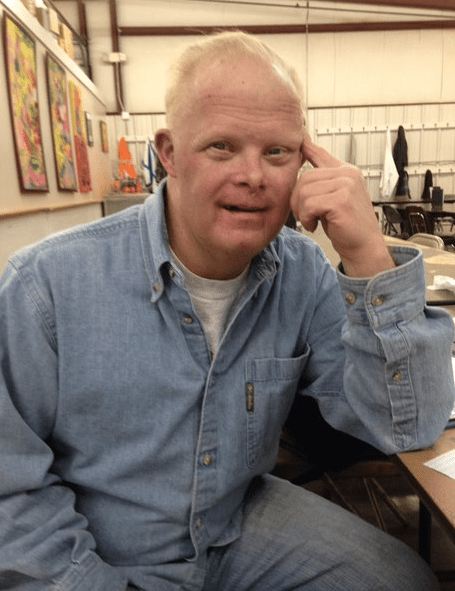Lealani Acosta
Nashville, Tennessee, United States
 |
| Photo courtesy of Lealani Mae Acosta. Permission granted by Teresa Briley-Scott. |
I had a succulent hanging from my office cabinet, suspended in a clear teardrop-shaped terrarium: its spiny green arches floated above a mound of fake snow, which I intermittently illuminated by touching the built-in switch that electrified interwoven fairy lights. It was a Christmas present from James’s sister. She had come to know me over the years as James’s neurologist for Trisomy 21 (Down syndrome) and Alzheimer’s disease.
What had struck me the most about James was his gentle smile—he was a natural people-person. I could see him being a favorite Kentucky Fried Chicken employee. His sister spoke proudly of his years living semi-independently. I easily pictured him clearing tables in his spotless uniform and greeting restaurant regulars. Over time, he slowly lost his skills at work, prompting medical evaluation and transfer to a group home.
His physical exam was memorable. As can be seen in Trisomy 21, he had baseline cardiac disease, and when I peeled off his socks for his neurological assessment, his feet were the most impressive shade of purple I had ever witnessed. Cognitive testing using my usual battery was replaced by a game of hiding objects around the room to see if he could find them again. His clinical history and amnestic presentation confirmed Alzheimer’s disease.
Seeing him again more recently, he had been balding and clean-shaven, but now had grown a goatee (which his sister hated) in imitation of a male caretaker. I was tickled to observe from his facial hair that he was a natural strawberry blonde. (After that caretaker left, he shaved off the goatee). His depression had a mixed response to antidepressant drugs. Some “seizures” had been witnessed by caretakers and he had been started on levetiracetam, an anti-epileptic drug (AED), at an outside hospital a couple of times. Levetiracetam had interrupted his sweet disposition with periods of anger and irritability, so I had weaned it off in the absence of epileptic evidence on EEG. At that visit, he was thankfully stable off levetiracetam.
Toward the end of the encounter, his sister presented me with the succulent. I initially protested, citing previous failures with multiple plants. Undeterred, she flipped a small switch underneath the container, turning on a string of twinkle lights dangling among the leaves, buried in a tiny ersatz snowdrift. She emphasized that hardy succulents were low maintenance. As loathe as I was to kill another plant, I could not say no. I hung the planter in view of my work computer and would turn on the fairy lights when I felt festive. I even occasionally remembered to water it.
A couple of months later, a panicked call from his sister had me rushing to the emergency department. James had begun “jerking” again and was finally able to be assessed at our hospital. His arms and legs flexed and lifted with enough momentum that his head almost jerked back, a stereotypical response that recurred every few minutes. He was as bright-eyed as ever. His niece sat by his bedside and, as his family decided laughter was better than fear, they held his hand and reassured him. “Ooh, that was a big one!” they would tease after a particularly vigorous convulsion.
 |
| Photo by Lealani Mae Acosta. |
I was frustrated at myself, worrying that I had failed him by not having maintained his AEDs. We had twice weaned him off them because of the behavioral side effects, and primarily because previous EEG had not captured any seizures or suspicious epileptiform activity. Thankfully, we quickly broke his seizures with intravenous levetiracetam and he was easily transitioned to oral.
We tried one more time to adjust his AEDs. Because of the behavioral changes from the levetiracetam, I had hoped lamotrigine, another AED with more mood-stabilizing properties, would also keep the seizures at bay. Over months, we had tapered up the lamotrigine and down the levetiracetam for his body to adjust. He was on a healthy maintenance dose of lamotrigine, with therapeutic levels, and a whisper of levetiracetam. I gave permission to discontinue the levetiracetam.
He made it three days before the seizures came back. I felt defeated, acquiescing the levetiracetam’s benefits outweighed the risks. We tapered off the lamotrigine and he remained seizure-free, with relatively preserved mood, on levetiracetam monotherapy. I kept telling myself we made the best decisions we could, weighing the input from his clinical evaluations and his family and caretakers’ input.
Roughly a month later, I accidentally broke the glass terrarium. I was to “bring something beautiful” to a meeting. I’d settled it into the middle console cupholder as I drove over, where it unfortunately sat perfectly in the trajectory of my backpack as I removed the bag from the passenger’s side. I groaned to hear the crinkle of glass, knowing immediately that I had shattered it. I hurriedly disposed of the fragments into an empty takeout bag, seized the plant, and rushed across the hospital plaza holding the intact base. I joked that the theme of my item was “beauty in brokenness,” as I turned on the still-functioning twinkle lights.
I brought it home and put it in a square glass planter with sides high enough to protect from the broken edges and returned it to my desk. It sits, proud and squat, near my computer mouse.
My jagged, ragged terrarium with its surviving succulent reminds me of James. Broken and redeemed by AEDs. Broken and redeemed, just like me.
In memoriam James Briley, beloved son, brother, uncle, employee, and diehard Elvis fan.
LEALANI MAE Y. ACOSTA, M.D., is an assistant professor of neurology at Vanderbilt University Medical Center in Nashville, Tennessee, USA.
Winter 2021 | Sections | Doctors, Patients, & Diseases

Leave a Reply